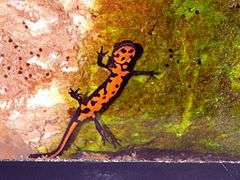Chinese fire belly newt
The Chinese fire belly newt (Cynops orientalis) is a small (2.2–4.0 inches (5.6–10.2 cm)) black newt, with bright-orange aposematic coloration on their ventral sides. C. orientalis is commonly seen in pet stores, where it is frequently confused with the Japanese fire belly newt (C. pyrrhogaster) due to similarities in size and coloration. C. orientalis typically exhibits smoother skin and a rounder tail than C. pyrrhogaster, and has less obvious parotoid glands.[2]
| Chinese fire belly newt | |
|---|---|
.jpg) | |
| Scientific classification | |
| Kingdom: | Animalia |
| Phylum: | Chordata |
| Class: | Amphibia |
| Order: | Urodela |
| Family: | Salamandridae |
| Genus: | Cynops |
| Species: | C. orientalis |
| Binomial name | |
| Cynops orientalis (David, 1873) | |
| Synonyms | |
|
Hypselotriton orientalis (David, 1873) | |
Chinese fire belly newts are mildly poisonous and excrete toxins through their skin. Consisting primarily of tetrodotoxins, newts of the genus Cynops pose a medically significant threat if enough toxins are consumed, and toxins may cause numbness or irritation on skin contact.[3]
 Underside
Underside- Underwater
- A pair
References
- Gu Huiqing; Geng Baorong (2004). "Hypselotriton orientalis". IUCN Red List of Threatened Species. 2004: e.T59442A11942170. doi:10.2305/IUCN.UK.2004.RLTS.T59442A11942170.en.
- "Caudata Culture Species Entry - Cynops orientalis - Chinese firebelly". Caudata.org.
- Brodie Jr., Edmund D.; Hensel Jr., John; Johnson, Judith (1974). "Toxicity of the Urodele Amphibians Taricha, Notophthalmus, Cynops and Paramesotriton (Salamandridae)". Copeia. 2 (2): 506–511. doi:10.2307/1442542. JSTOR 1442542.
Further reading
| Wikimedia Commons has media related to Hypselotriton orientalis. |
- Chang, Mangven L. Y. 1936. Contribution à l'étude Morphologique, Biologique et systématique des Amphibiens urodèles de la Chine. Libraire Picart, Paris, 156 p.
